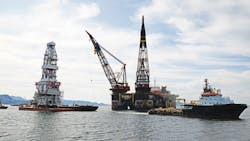Thialf connects Sverdrup drilling deck
Thialf connects Sverdrup drilling deck
Statoil continues to squeeze costs at the Johan Sverdrup project in the North Sea, with the construction program currently around 60% complete. The latest estimate for Phase 1 is down by around $640 million to $12 billion, 25% below the figure budgeted in the original development plan.
Last month Heerema Marine Contractors’ crane vesselThialf lifted and mated the three main topsides modules for the drilling platform, built by Aibel and Nymo in Norway and Thailand, at the Klosterfjorden in western Norway. Collectively the structures weighed 21,250 tons, and the inshore marine operation was one of the largest-scale to date in Norway, Aibel claimed. A barge subsequently transported the completed deck to Aibel’s yard in Haugesund where it will remain through the winter for an extensive onshore commissioning program. It will sail to the field location next summer, with Aibel also responsible for hookup at the four-platform Phase 1 field center.
Statoil and its partners are seeking to extend the life of the Veslefrikk field oil and gas in block 30/3 of the North Sea until 2025 by upgrading the facilities, according to Norway’s Industri Energi union. The field came onstream in 1989 via Veslefrikk B, Norway’s first floating platform, bridge linked to a steel wellhead platform, Veslefrikk A.
Norway, Isle of Man progress license rounds
Norway’s latest Awards in Pre-Defined Areas (APA) licensing round drew the highest number of bids since the government introduced the scheme in 2003. Thirty-nine companies participated, including some with no prior track record on the Norwegian shelf; and the total number of applications was 20% higher than the previous record, for APA 2014.
Torgeir Stordal, Exploration Director at the Norwegian Petroleum Directorate (NPD), commented: “A lot of new seismic has been acquired in recent years, which has contributed to an improved understanding of the subsurface. At the same time, cost reductions have contributed to improved profitability in the projects.” Awards should follow early next year.
The Isle of Man’s government has also opened an offshore licensing round, designed in part to capitalize on the UK’s current 30th round, which includes areas of the Irish Sea close to the island. The Department of Economic Development hopes to incentivize companies interested in an overall view of prospectivity in this region. An Isle of Man seismic data room has opened in Edinburgh, run by the British Geological Survey: applications are due in by Dec. 10, 2017.
Drombeg, Korpfjell fail to deliver
Frontier drilling took a knock this summer following disappointing results from two high-cost wells. Providence Resources’ dual-target Druid/Drombeg well in the southern Porcupine basin, 220 km (137 mi) offshore southwest Ireland, was seen as a potential play-opener in the region, and the water depth of 2,233 m (7,326 ft) was the deepest of any Irish well to date. Both targets, however, turned out to be porous water-bearing reservoirs, although analysis of drill cuttings from the Drombeg section indicated the potential presence of bitumen.
Statoil’s well on the Korpfjell prospect, the first in the newly opened southeastern part of the Norwegian Barents Sea, delivered sub-commercial volumes of gas. The location was 420 km (261 mi) from the Norwegian mainland. Statoil said it would persevere with plans to drill other wildcats in the region, including the Korpfjell license. Partner Lundin Norway was undeterred by the result, reaffirming its commitment to a well next year on the Signalhornet prospect, 300 km (186 mi) south of Korpfjell, with further wells lined up on emerging plays on the Loppa High and Filicuci trends in the southern Barents Sea.
Total builds North Sea production
Total’s $7.5-billion acquisition of Maersk Oil is the biggest North Sea weighted deal since the merger between Statoil and Norsk Hydro in 2006, according to analyst Wood Mackenzie. The transaction, expected to go through next spring, includes the operated HP/HT Culzean gas/condensate development in the UK central North Sea, close to Total’s Elgin-Franklin hub; an 8.444% stake in the Johan Sverdrup development in the Norwegian sector; and 31.2% of the DUC producing fields in the Danish North Sea, with net associated production of around 60,000 boe/d. Maersk has other production interests elsewhere, but Dr. Valentina Kretzschmar, Corporate Service Director at Wood Mackenzie, said that for Total, “the deal is first and foremost about consolidation in the North Sea. Cost synergies should add value, with the North Sea a key area of overlap.”
Total has boosted its own UK offshore production by delivering first gas/condensate from the Edradour and Glenlivet fields west of Shetland via a 56-km (35-mi), three-well subsea tieback to existing facilities serving the Laggan-Tormore project. The extra volumes should increase overall throughput by up to 56,000 boe/d.
OGA targets more from UK fields
Britain’s Oil & Gas Authority (OGA) has issued a report on the oil recovery potential from the UK’s offshore fields. The benchmarking report currently anticipates an overall recovery factor of 43%, but OGA believes that improved stewardship of assets could raise the figure. It has identified certain fields where new measures could deliver a further 900 MMbbl of (combined) production. BP plans to use some of the findings from the report to help maximize recovery from its UK offshore fields. Edinburgh-based consultant Belltree developed the recovery factor benchmarks for the report for more than 400 UK oil and gas fields, deploying proven analogue field benchmarking techniques that it has applied in other parts of the world.
Trade association Oil & Gas UK’s latestEconomic Report says that this year’s UK North Sea asset transactions may provide the sector with a sorely needed investment boost, and recent efficiency gains are helping to restore the UK’s position as an attractive basin. However, the association remains concerned by the continued low level of UK offshore exploration and appraisal drilling activity, and the fact that only three new field approvals have been sanctioned since early 2016.


